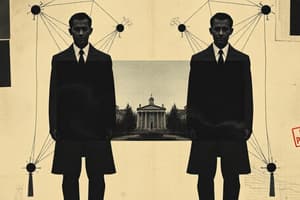Podcast
Questions and Answers
The ______ refers to the phenomenon where a person's memory of an event is changed by misleading information introduced after the event.
The ______ refers to the phenomenon where a person's memory of an event is changed by misleading information introduced after the event.
misinformation effect
The ______ occurs when an individual remembers a fact or event but incorrectly attributes the source of that memory.
The ______ occurs when an individual remembers a fact or event but incorrectly attributes the source of that memory.
source effect
The ______ describes a situation where a witness's attention is primarily drawn to a weapon during a crime, which reduces their ability to remember other details.
The ______ describes a situation where a witness's attention is primarily drawn to a weapon during a crime, which reduces their ability to remember other details.
weapon focus effect
Compared to showups, ______ generally lead to more accurate identifications when conducted fairly using double-blind procedures and sequential presentation.
Compared to showups, ______ generally lead to more accurate identifications when conducted fairly using double-blind procedures and sequential presentation.
Showups are more likely to result in false identifications due to their inherent ______, as the witness is only presented with a single suspect.
Showups are more likely to result in false identifications due to their inherent ______, as the witness is only presented with a single suspect.
Eyewitness confidence is most likely to correlate with accuracy when the identification is made during ______ and under high-quality viewing conditions.
Eyewitness confidence is most likely to correlate with accuracy when the identification is made during ______ and under high-quality viewing conditions.
Suggestive feedback can artificially inflate a witness's confidence, making their certainty in the identification ______ related to the actual accuracy of their memory.
Suggestive feedback can artificially inflate a witness's confidence, making their certainty in the identification ______ related to the actual accuracy of their memory.
A long delay between the event and the identification can weaken the relationship between a witness's confidence and the accuracy of their identification because memories can ______ over time.
A long delay between the event and the identification can weaken the relationship between a witness's confidence and the accuracy of their identification because memories can ______ over time.
Using ______ lineups, where neither the administrator nor the witness knows who the suspect is, is one way to improve eyewitness accuracy during identification procedures.
Using ______ lineups, where neither the administrator nor the witness knows who the suspect is, is one way to improve eyewitness accuracy during identification procedures.
Presenting lineup members ______, rather than all at once, can improve eyewitness accuracy by reducing the likelihood of relative judgments.
Presenting lineup members ______, rather than all at once, can improve eyewitness accuracy by reducing the likelihood of relative judgments.
To avoid skewing a witness's identification, law enforcement should provide ______ that do not lead the witness to believe the suspect is definitely in the lineup.
To avoid skewing a witness's identification, law enforcement should provide ______ that do not lead the witness to believe the suspect is definitely in the lineup.
Conducting ______ can compromise eyewitness accuracy, as witnesses may conform their identification to previous choices.
Conducting ______ can compromise eyewitness accuracy, as witnesses may conform their identification to previous choices.
A ______ involves asking open-ended questions to encourage witnesses to recall details without being prompted or led, thereby improving the completeness and accuracy of their accounts.
A ______ involves asking open-ended questions to encourage witnesses to recall details without being prompted or led, thereby improving the completeness and accuracy of their accounts.
To ensure the accuracy of eyewitness identifications, each lineup should feature ______ at a time, preventing the witness from being overwhelmed and pressured.
To ensure the accuracy of eyewitness identifications, each lineup should feature ______ at a time, preventing the witness from being overwhelmed and pressured.
Lineups should be constructed so that the suspect ______ among the fillers, ensuring that the identification is based on memory rather than superficial characteristics.
Lineups should be constructed so that the suspect ______ among the fillers, ensuring that the identification is based on memory rather than superficial characteristics.
To maintain objectivity, a ______ should be used, preventing lineup administrators from influencing or signaling the witness either intentionally or unintentionally.
To maintain objectivity, a ______ should be used, preventing lineup administrators from influencing or signaling the witness either intentionally or unintentionally.
In the case of Manson vs. Braitwaite (1977), the Supreme Court outlined five criteria to evaluate the ______ of eyewitness testimony.
In the case of Manson vs. Braitwaite (1977), the Supreme Court outlined five criteria to evaluate the ______ of eyewitness testimony.
One of the Manson criteria considers the witness's ______ to view the suspect during the event, as a longer and clearer view typically leads to more accurate memories.
One of the Manson criteria considers the witness's ______ to view the suspect during the event, as a longer and clearer view typically leads to more accurate memories.
Another of the Manson criteria is the witness's ______ during the event, as focused attention increases the likelihood of encoding accurate details into memory.
Another of the Manson criteria is the witness's ______ during the event, as focused attention increases the likelihood of encoding accurate details into memory.
The ______ of the witness's prior description of the suspect is a key factor in determining the reliability of their identification.
The ______ of the witness's prior description of the suspect is a key factor in determining the reliability of their identification.
Flashcards
Misinformation Effect
Misinformation Effect
Memory of an event is altered by misleading information presented after the event.
Source Effect
Source Effect
Misattributing the source of a memory; remembering a fact but not where it was learned.
Weapon Focus Effect
Weapon Focus Effect
Witness focuses on a weapon during a crime, reducing their ability to recall other details.
Accuracy in Lineups
Accuracy in Lineups
Signup and view all the flashcards
Accuracy in Showups
Accuracy in Showups
Signup and view all the flashcards
When Confidence and Accuracy are Related
When Confidence and Accuracy are Related
Signup and view all the flashcards
When Confidence and Accuracy are NOT Related
When Confidence and Accuracy are NOT Related
Signup and view all the flashcards
Ways to Improve Eyewitness Accuracy
Ways to Improve Eyewitness Accuracy
Signup and view all the flashcards
Pristine Conditions for Accurate Identification
Pristine Conditions for Accurate Identification
Signup and view all the flashcards
Manson Criteria
Manson Criteria
Signup and view all the flashcards
Study Notes
- Concerns the misinformation effect, source effect, weapon focus effect, accuracy from lineups vs showups, relationship between eyewitness confidence and identification accuracy, ways to improve eyewitness accuracy, pristine conditions for accurate witness identification, and the Manson criteria for evaluating eyewitness testimony accuracy.
Psychological Effects on Memory
- Misinformation effect: Memory of an event is altered by misleading information introduced after the event.
- Source effect: Misattributing the source of a memory, remembering a fact but not where it was learned.
- Weapon focus effect: When a weapon is present during a crime, the witness focuses on the weapon, reducing their ability to recall other details.
Lineups Vs. Showups
- Lineups lead to more accurate identification when conducted fairly using double-blind and sequential methods.
- Showups have a higher risk of false identification due to suggestiveness.
Eyewitness Confidence and Identification Accuracy: Related Conditions
- Related: Initial immediate identifications, high-quality viewing conditions, and proper lineups.
- Accuracy of eyewitness identification is related to their confidence at initial identification.
- High-quality viewing conditions aid in more accurate and confident eyewitness identifications
- Proper lineups, designed to reduce bias, contribute to the relationship between confidence and accuracy.
Eyewitness Confidence and Identification Accuracy: Unrelated Conditions
- Confidence is not related: After suggestive feedback, long time between event and identification, poor viewing conditions
- Suggestive feedback can inflate confidence without improving accuracy.
- A long time between the event and identification diminishes the reliability of confidence.
- Poor viewing conditions undermine both accuracy and the reliability of confidence.
Improving Eyewitness Accuracy
- Employ double-blind lineups
- Use sequential lineups (one after another).
- Avoid confirming feedback to prevent inflated confidence.
- Avoid leading instructions to minimize bias.
- Avoid multiple identifications
- Employ cognitive interviews to enhance memory recall.
Pristine Conditions for Accurate Witness Identification
- Present only one suspect at a time in the lineup.
- Construct the lineup so the suspect does not stand out.
- Provide unbiased instructions to the witness.
- Use a double-blind procedure.
- Obtain an immediate confidence statement from the witness.
Manson Criteria (Manson vs. Braitwaite, 1977)
- Opportunity to view the suspect: the amount of time and clarity of the witness's view.
- Degree of attention: The witness's focus on the suspect during the event.
- Accuracy of prior description: How well the witness's initial description matches the suspect.
- Level of certainty: The witness's confidence in the identification.
- Time elapsed: The duration between the event and the identification.
Studying That Suits You
Use AI to generate personalized quizzes and flashcards to suit your learning preferences.




